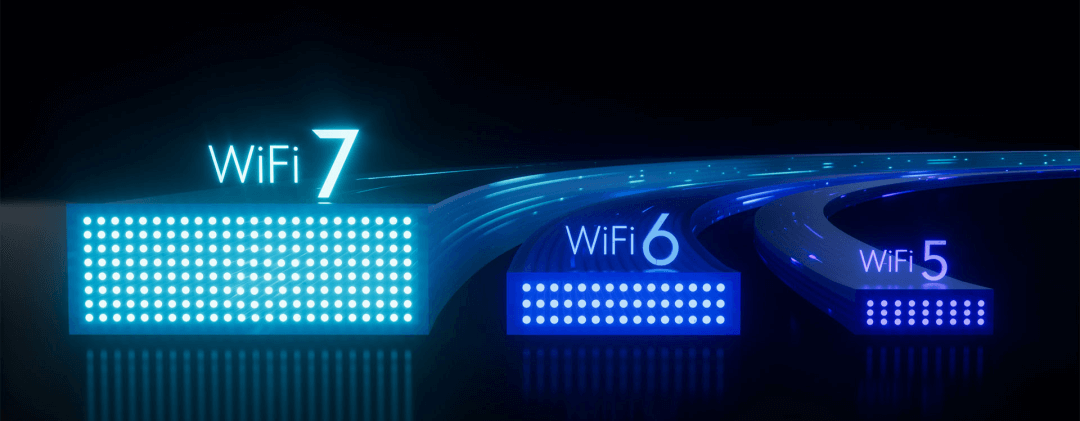
In today's digital age, the Internet has become an indispensable part of people's lives and work. Wireless network technology is one of the important means to achieve Internet connection. As people's demand for wireless network speed, capacity and efficiency continues to grow, WiFi technology is also evolving.
WiFi 7 is a major upgrade after WiFi 6. It combines all the advantages of WiFi 6/6E and introduces many revolutionary features. The launch of WiFi 7 will further improve network speed, capacity and efficiency, bringing users a better network experience. This article will explore the characteristics and advantages of WiFi 7 in depth and take you to understand this technology.
Understanding WiFi 7
WiFi 7, also known as IEEE 802.11be, represents the next generation of wireless networking standards. Building on the foundation laid by WiFi 6 and WiFi 6E, WiFi 7 is designed to offer unprecedented data rates and improved efficiency. While WiFi 6 introduced features like Orthogonal Frequency Division Multiple Access (OFD
MA) and Target Wake Time (TWT) to enhance performance, WiFi 7 takes these innovations further, aiming to deliver Extremely High Throughput (EHT) and improved spectrum utilization. This advancement is crucial as the demand for faster and more reliable internet connections continues to grow, driven by the increasing number of connected devices and bandwidth-intensive applications.

Key Features of WiFi 7
WiFi 7 is characterized by several groundbreaking features that set it apart from its predecessors:
Extremely High Throughput (EHT): WiFi 7 is expected to support data rates up to 30 Gbps, significantly higher than WiFi 6’s maximum of 9.6 Gbps. This boost in speed will enhance the user experience, particularly in data-intensive applications like 8K video streaming and virtual reality. The ability to deliver such high throughput is essential for supporting future technological advancements that demand high-speed data transmission.
Enhanced Multi-Link Operation (MLO): One of the standout features of WiFi 7 is its ability to use multiple links simultaneously. This multi-link operation allows for more stable connections and reduces latency, making it ideal for applications that require real-time responsiveness, such as online gaming and video conferencing. By utilizing multiple frequency bands at once, WiFi 7 can intelligently manage network traffic, ensuring consistent performance even in congested environments.
Wider Channels and Better Spectrum Utilization: WiFi 7 supports wider channels of up to 320 MHz, compared to WiFi 6's 160 MHz. This increased bandwidth allows for more data to be transmitted at once, improving overall network capacity and efficiency. The use of wider channels is particularly beneficial in areas with high device density, where network traffic can easily become congested.
Improved Latency and Connectivity Stability: With advanced features like MLO and wider channels, WiFi 7 significantly reduces latency, ensuring that devices remain connected without interruptions. This improvement is crucial for emerging technologies that require stable and fast connections, such as autonomous vehicles and remote-controlled machinery.
Parameter Comparison of WiFi 5, WiFi 6, WiFi 6E, and WiFi 7 | ||||
Features | WiFi 5 | WiFi 6 | WiFi 6E | WiFi 7 |
IEEE Standards | 802.11ac
| 802.11ax
| 802.11ax Extension | 802.11be
|
Maximum Speed | 3.5Gbps | 9.6Gbps | 9.6Gbps | 46Gbps |
Bands | 2.4GHz、5GHz | 2.4GHz、5GHz | 6GHz | 2.4GHz、5GHz和6GHz |
Multi-Link Operation | Not Support | Support | Support | Support |
Safety | WPA2 | WPA3 | WPA3 | WPA3 |
Channel Width | 20, 40, 80, 160MHz | 20, 40, 80, 160MHz | 20, 40, 80, 160MHz | 20, 40, 80, 160, 320MHz |
Modulation | 256-QAM Modulation | 1024-QAM Modulation | 1024-QAM Modulation | 4096-QAM OFDMA Modulation |
Multiple-Input & Multiple Output | Support 4X4 MIMO | Support 8X8 UL/D/MU-MIMO | Support 8X8 UL/D/MU-MIMO | Support 16X16 UL/D/MU-MIMO |
Benefits of WiFi 7
The introduction of WiFi 7 offers numerous benefits that will transform how we use wireless networks:
Faster Internet Speeds and Increased Capacity: With its enhanced throughput capabilities, WiFi 7 can handle more devices simultaneously without compromising speed. This capacity increase is essential for environments with high device density, such as offices, schools, and public spaces. Consumers will also notice improved performance in their homes, where multiple devices often compete for bandwidth.
Enhanced Support for Emerging Technologies: WiFi 7 is designed to accommodate the growing demands of modern technology, including 8K video, augmented reality (AR), and virtual reality (VR). These applications require high data rates and low latency, both of which WiFi 7 can deliver. The ability to support these technologies will drive innovation across various sectors, from entertainment to healthcare.
Improved Responsiveness for Online Gaming and Real-Time Applications: Gamers and professionals who rely on real-time applications will benefit from WiFi 7’s reduced latency and stable connections, ensuring smooth and uninterrupted experiences. This improvement will enhance competitive gaming environments and facilitate more effective remote work setups.

Applications and Use Cases
WiFi 7's capabilities unlock new possibilities across various sectors:
Impact on Industries: In healthcare, WiFi 7 can support telemedicine and remote surgeries with low latency connections, enabling doctors to perform procedures from afar with precision. In education, it enables seamless online learning experiences with high-definition video streaming, allowing for interactive and immersive virtual classrooms.
Smart Homes and IoT Devices: As the number of connected devices in homes continues to grow, WiFi 7 ensures that each device receives the bandwidth it needs, from smart thermostats to security cameras. This capability is essential for the development of smart homes, where devices must communicate efficiently to provide a cohesive user experience.
Future-Proofing Network Infrastructure: Businesses looking to invest in long-term network solutions will find WiFi 7's scalability and performance enhancements to be a valuable asset for future-proofing their infrastructures. By adopting WiFi 7, companies can ensure that their networks remain competitive and capable of supporting future technological advancements.
Lastest Application
Apple's 16 series products were released on September 9, 2024
According to the technical specification documents released by Apple, the latest iPhone 16, iPhone 16 Plus, iPhone 16 Pro and iPhone 16 Pro Max all support the latest WiFi standard: 802.11be.
Challenges and Considerations
Despite its promising features, the transition to WiFi 7 presents challenges:
Transition from Existing Technologies: Upgrading to WiFi 7 requires new hardware, which can be costly for both consumers and businesses. Compatibility with existing devices and infrastructure will also need to be addressed. Consumers may need to replace routers and other networking equipment to fully benefit from WiFi 7's capabilities.
Potential Costs and Infrastructure Requirements: Implementing WiFi 7 may involve significant investment in new routers and access points, as well as potential upgrades to network infrastructure to fully leverage its capabilities. Businesses must weigh these costs against the potential benefits to determine if the investment is justified.
Future Trends
As WiFi 7 is still in its early stages, its full potential is yet to be realized. However, several trends and developments are expected:
Timeline for Adoption: Industry experts predict that WiFi 7 will see widespread adoption by the mid-2020s, as manufacturers begin to release compatible devices and routers. As more devices become available, adoption rates will likely increase, driving further innovation in wireless technology.
Ongoing Research and Enhancements: Researchers continue to explore ways to further enhance WiFi technology, focusing on improving efficiency and expanding capabilities. These efforts will likely lead to new features and optimizations that enhance WiFi 7's performance and usability.
Predictions for Wireless Connectivity Evolution: As wireless technologies evolve, WiFi 7 will likely serve as a foundation for future innovations, paving the way for even more advanced connectivity solutions. This evolution will support the development of new applications and industries, enabling a more connected and efficient world.
Conclusion
WiFi 7 represents a significant leap forward in wireless technology, offering faster speeds, higher capacity, and improved reliability. As we move toward a more connected world, the benefits of WiFi 7 are poised to transform industries and enhance our daily lives.
To learn more about WiFi technology, please follow VCOM's updates.
Tag:WiFi 7




